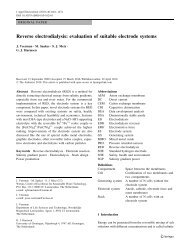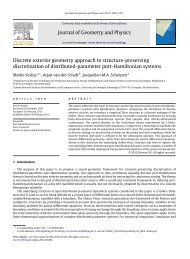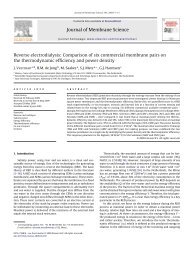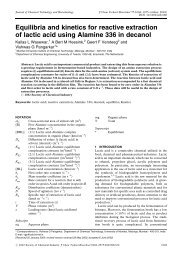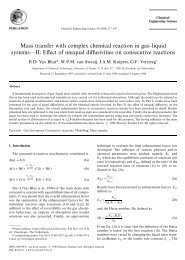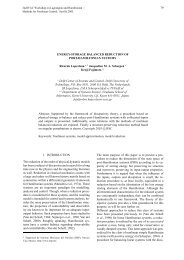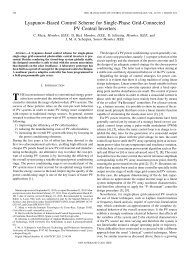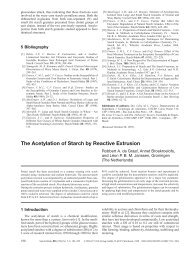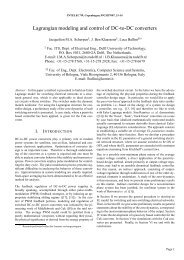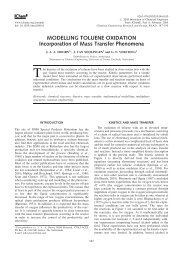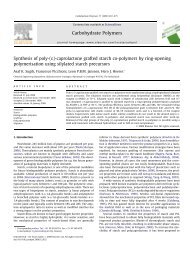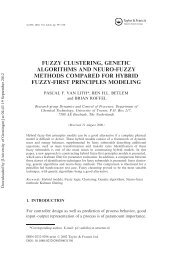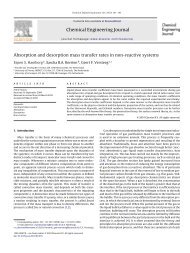Mass transfer with complex chemical reaction in gas—liquid ... - ITM
Mass transfer with complex chemical reaction in gas—liquid ... - ITM
Mass transfer with complex chemical reaction in gas—liquid ... - ITM
Create successful ePaper yourself
Turn your PDF publications into a flip-book with our unique Google optimized e-Paper software.
134 R.D. Vas Bhat et al./Chemical Eng<strong>in</strong>eer<strong>in</strong>g Science 54 (1999) 121—136Table 4Selection of enhancement factors at different Hatta numbers. Further parametric values given <strong>in</strong> Table 1 and the respective figuresFig. k k Ha E K "10 K "10 K "11(a) 1.0010 1.0010 1 1.4 1.4 1.47.8110 1.0010 128 73.4 74.5 104.59.7710 1.0010 1024 100.2 143.8 195.93.0510 5.1210 741,460 201.0 201.0 201.0K "10 K "1 K "10 2 1.0010 2.50 10!1 1 1.36 1.36 1.367.8110 2.50 10!1 128 5.10 5.18 5.189.7710 2.50 10!1 1024 5.18 6.27 7.799.7710 1.31 10 741,460 5.20 6.56 8.85K "10 K "1 K "10 4(a) 1.0010 2.50 10!1 1 1.29 1.35 1.367.8110 2.50 10!1 128 1.69 2.78 4.359.7710 2.50 10!1 1024 3.03 4.99 6.819.7710 1.31 10 74,1460 3.78 5.90 7.57Loaded solutions6(a) k k Ha K "0.01; α"0.45 1.0010 2.9810 1 1.157.8110 2.9810 128 1.289.7710 2.9810 1024 1.339.7710 1.7710 788,200 1.34K "100; α"0.91.0010 4.2110 1 1.097.8110 4.2110 128 1.149.7710 4.2110 1024 1.579.7710 2.2110 741,450 3.95qεθ " K (῟#(E !1)/q!2ε#2῟) !q A B <strong>with</strong>(16c)῟" C , B῟" D , B῟" E and q" B .B A !A The above set of equations can be solved for both loadedand unloaded solutions. The only difference be<strong>in</strong>g thatfor unloaded solutions the <strong>in</strong>itial concentrations of all the<strong>chemical</strong> species is taken as zero.For <strong>in</strong>stantaneous reversible consecutive <strong>reaction</strong>,HaPR and θ"1. With this simplification E and ε can be calculated simultaneously from Eq. (16b) and(16c). This was carried out us<strong>in</strong>g commercially availablesoftware (MAPLE V). The results are presented as parityplots <strong>with</strong> respect to numerical obta<strong>in</strong>ed values [Fig. 7(a)and (b)]. The figures show that the match between theapproximate technique and numerical values is veryclose <strong>with</strong> maximum deviation of 1.3% for unloadedsolutions and 0.3% for loaded solutions <strong>with</strong> an α of 0.1.7. ConclusionsA numerical model based on the Higbie penetrationtheory for isothermal reversible consecutive <strong>chemical</strong> <strong>reaction</strong>has been presented <strong>in</strong> this paper. The model hasbeen successfully validated for simpler <strong>reaction</strong>stoichiometries.It has been shown that, although the Onda technique(Onda et al., 1970, 1972) for enhancement factors of irreversibleconsecutive <strong>reaction</strong>s is useful <strong>in</strong> determ<strong>in</strong><strong>in</strong>g the<strong>in</strong>termediate asymptotic enhancement factor and thef<strong>in</strong>al <strong>in</strong>f<strong>in</strong>ite enhancement factor, there is some deviationfrom numerical results for the <strong>in</strong>termediate enhancementfactor (max. 6% for film theory and 4.3% for penetrationtheory).For reversible consecutive <strong>reaction</strong>s, it has been shownthat the f<strong>in</strong>al <strong>in</strong>f<strong>in</strong>ite enhancement (E ) can be seen asa contribution of the <strong>in</strong>f<strong>in</strong>ite enhancement of the first<strong>reaction</strong> (E ) along <strong>with</strong> the additional enhancementprovided by the second <strong>reaction</strong> (E ). This was quantitativelyshown for irreversible—reversible <strong>reaction</strong>s.For the case of solute load<strong>in</strong>g, enhancement factorsobta<strong>in</strong>ed are lower than that for the unloaded case.Unlike unloaded solutions, the value of K affects the<strong>in</strong>termediate asymptotic enhancement value for the caseof loaded solutions. F<strong>in</strong>ally, an approximate technique todeterm<strong>in</strong>e f<strong>in</strong>al <strong>in</strong>f<strong>in</strong>ite enhancement factors based on themethod of DeCoursey (1982) has been presented forconsecutive reversible <strong>reaction</strong>s <strong>with</strong> equal diffusivities.The match <strong>with</strong> numerically obta<strong>in</strong>ed values is very goodfor both loaded and unloaded solutions.



